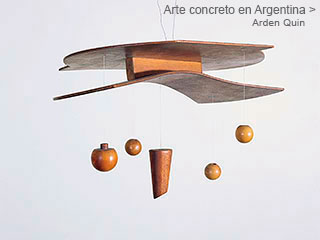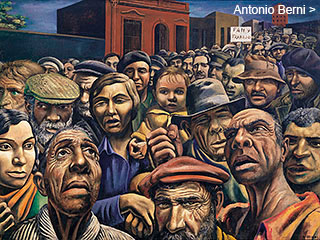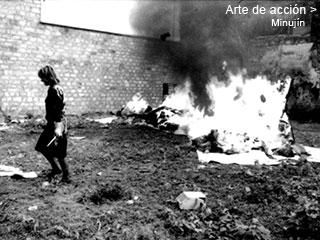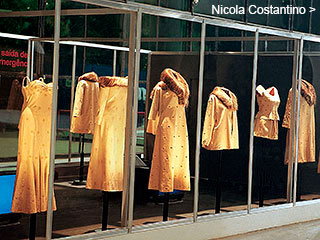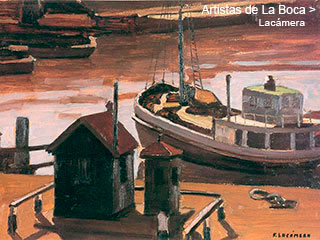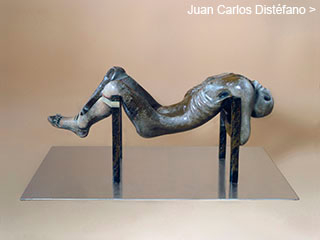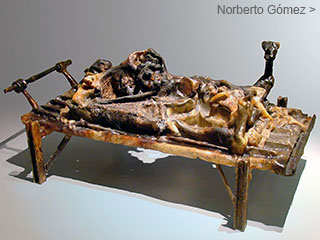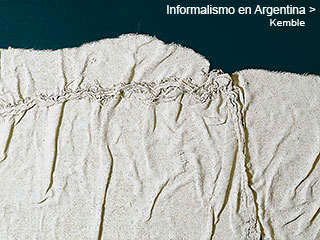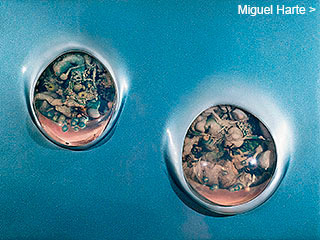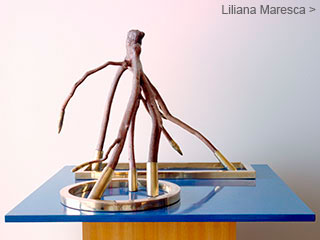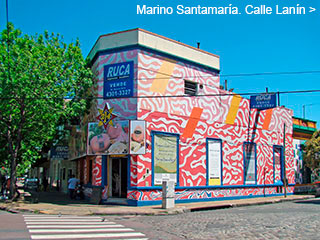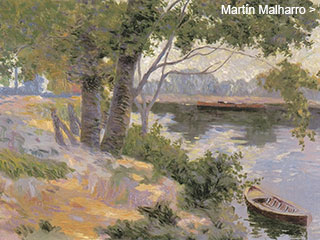Menú
Algunos dossiers
Concrete Art
in Argentina
in Argentina
by
Adriana Lauria
January 2003
January 2003
Abstraction asserted itself in Argentina through the achievements of groups such as Arte Concreto-Invención, Madí and Perceptismo, which developed their activity since the second half of the 1940s. These groups constituted the first organized national avant-garde and made their aesthetics known to the public through exhibitions, magazines, manifestoes, leaflets, lectures, etc.
2. Arturo, the previous instants
Arturo, the previous instants
The publishing of the only issue of Arturo in the summer of 1944 is usually considered as the primary event of Concrete art in Argentina. A series of facts preceded and prepared the cultural ground so that the editing group, formed by the artists Carmelo Arden Quin, Rhod Rothfuss, Gyula Kosice, Tomás Maldonado, Lidy Prati and the poet Edgard Bailey, could make known in Buenos Aires this first “Abstract arts magazine”.
Arden Quin and Torres García
In 1935, young Uruguayan artist Arden Quin met in Montevideo Torres García. Through the latter’s preaching Arden Quin got acquainted with trends such as those of abstract or non-figurative art, the Russian Constructivism; with names of artists like Mondrian and Kandinsky, with the labor of groups like Circle et carré and with the significance of their magazines. 
They met again in 1939 and Arden Quin could then see Pez en madera recortada (Fish in trimmed Wood) and Torres’ articulate toys, from which he would later develop his transformable sculptures. Rhod Rothfuss went with Arden Quin to some of these meetings.
The abstract work of Fontana
Born in Argentina but educated in Italy, Lucio Fontana developed at the beginning of the 30s a progressively synthetic line of work. In 1934 he produced a series of abstract sculptures with thin spatial signs, relieves and cut tablets, trimmed in constructive or free shapes. He took part with these works in the group of abstract artists who gathered around the Galleria del Milione. 
Drawings and engravings by this group integrated an exhibition opened at the Moody gallery in Buenos Aires, by the end of 1936. Works by future Madist Juan Bay, by Enzio D’Errico, Fontana, Fausto Melotti, Mario Radice, Mauro Reggiani, Atanasio Soldati and Luigi Veronesi were shown there.
According to Attilio Rossi, one of the organizers, in Sur magazine, the exhibition had a good reception on the part of the local critics. It is amazing to see the fact that the title –Primera exposición de dibujos y grabados abstractos (First Exhibition of Abstract Drawings and Engravings)– as well as the aftermaths of the show did not include any mention at all to such cases in the national scope as those of Pettoruti and specially Del Prete. Del Prete, after being part of the Abstraction Création group in 1932 –a connection Rossi pointed out in his article but with respect to the Italians– continued to exhibit abstract works, since 1933, at Amigos del Arte. 
Torres García in Buenos Aires
After resuming his contacts with the intellectual milieu in Buenos Aires, Torres García showed his works at Galería Müller during 1942. In 1944 the Salón de pintores modernos uruguayos (Uruguayan Modern Painters Salon) took place at the Comte gallery including works by Barradas, Cúneo, Figari, Amalia Nieto, Horacio and Augusto Torres and Joaquín Torres García. Soon after issued his book El Universalismo Constructivo. Contribución a la unificación del Arte y la Cultura de América, which gathered a hundred and forty nine lectures and contained three hundred and fifty original drawings, published by Poseidón.
As an outcome of these facts, Alfredo Hlito got in touch with the work and theories of Torres García, an influence that would show in the works produced by Hlito in 1945, when he merged an orthogonal reticule with circular or semicircular shapes that kept the abstract nature of the compositions. 
Grete Stern’s contribution
The German photographer Grete Stern studied in her country with Walter Peterhans and in 1929, with her mate Ellen Auerbach, she opened in Berlin ringl+pit, a studio that was perhaps one of the most daring ones of its time and outstood because of the audacious images they supplied to advertising campaigns. After following Peterhans in the Bauhaus courses Stern went back to Berlin, where she met the Argentine photographer Horacio Coppola, her future husband.
At the rising of Nazism, the couple emigrated to London and in 1936 they travelled to Buenos Aires, where they definitively settled. That year an exhibit of her works was organized at the offices of Sur magazine. 
Stern introduced innovative criteria in Argentina’s photography. She spread among the intellectuals of that time the fundamentals of avant-garde art and design, mainly those coming from the Bauhaus. At her home were held “meetings attending young plastics and writers. Those discussions about the avant-gardes’ aesthetic theories were one of the starting points of Argentine modern art”. 
In 1945, the editing group of Arturo magazine performed their second show, introduced as Movimiento de Arte Concreto-Invención, at her house in Ramos Mejía.
* * *
Emerging from a cultural process that tended to the modernization of the country, the Argentine Concrete movement settled and grew up, in spite of certain inconstancies and resistances, as an outcome of a complex cultural network of which these facts were only a part.
The opportunity was promising. The productive forces of the North had been taken by World War II and the European cultural evolution seemed to have moved away. It was the moment to deploy thinking and a creativity to settle Argentina in a contemporaneity that, sooner or later, globalization would demand of it.


